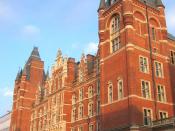Ralph Vaughan Williams - Symphony Number Five
Ralph Vaughan Williams, descended from the famous Wedgwood and Darwin families, was born at Down Ampney, Gloucestershire in 1872. In 1890 he entered the Royal College of Music, and in 1892 he entered Trinity College, Cambridge. One of the greatest of the British composers, a prolific writer of music, folksong collector, and champion of British cultural heritage, he died aged 85 in 1958. His ashes are interred in Westminster Abbey alongside the nation's greatest artists and poets.
Symphony No. 5 in D
Introduction
The symphony contains a lot of material from RVW's then unfinished opera, The Pilgrim's Progress. When he began the Fifth Symphony, RVW thought he may never finish the opera, and didn't want to waste any good ideas. The symphony does not have a programme, it is absolute music. It is in four movements: a 'Preludio' first movement, a Scherzo, a 'Romanza' slow movement, and a 'Passacaglia' finale.
First Movement : Preludio
From the very beginning, RVW puts the key signature of this movement into doubt. The movement opens with a horn call in D, set against a firm base (or bass?) of octave C's. Could it be that in the great traditions of British musical 'amateurism', RVW got his transposition wrong? Or is this a deliberate feature of the music, intended to blur the tonality? Musicologists prefer the latter explanation. This is by no means an unusual feature of his music, when he was asked what the 4th symphony was about, RVW replied 'It is about F-minor', alluding to his sometimes hazy tonalities, often augmented by his use of modal, mainly pentatonic melodies, which, with no leading note, often help to 'fudge' the tonality. Apart from the horn call, the brass is seldom used, and the texture is...


